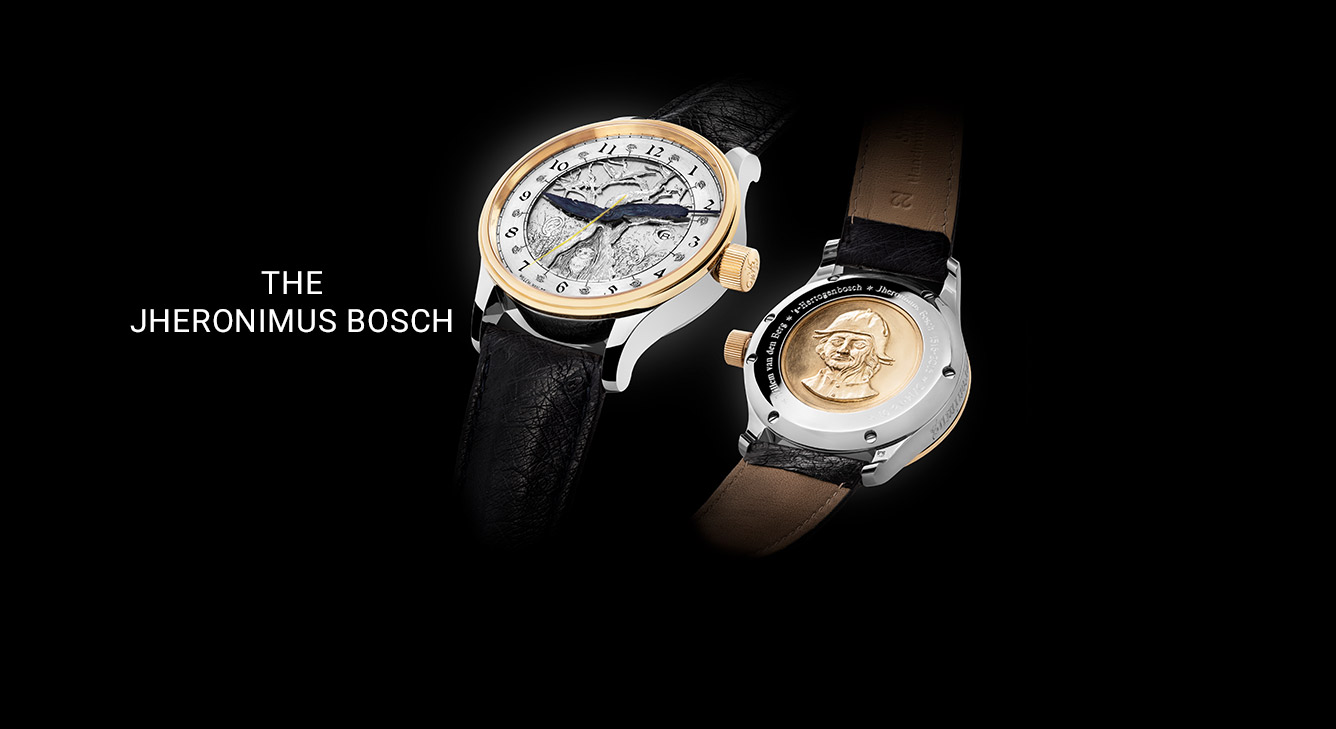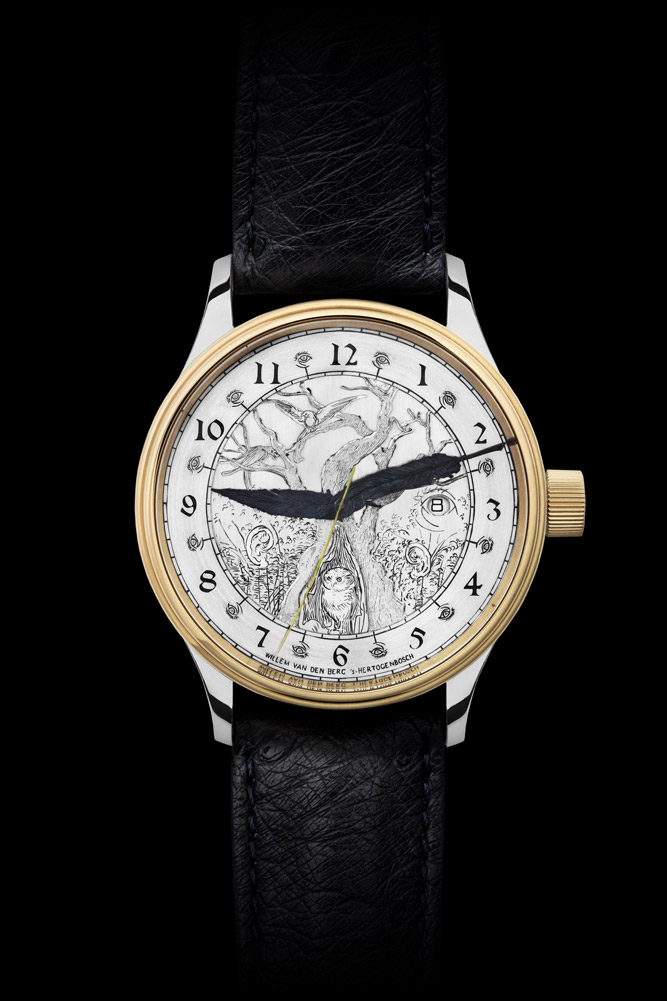
“THE JHERONIMUS BOSCH WATCH”
THE DUTCH MASTER
The year 2016 was dedicated to the five-hundredth date of death of Jheronimus Bosch (approx.1450-1516). His famous paintings on which he displayed fierce scenes with beasts, monsters and devils are globally very well known. On contrary, his fabulous drawings are much less famous.
Willem van den Berg was inspired by the drawings of Jheronimus Bosch, which can be seen as small self-contained pieces of art, and he built a special watch as an ode to the master-draftsman that does justice to the status he acquired. It illustrates the role of Jheronimus Bosch as a pioneer of the Dutch draftmanship. Central in the watch is the drawing “Het woud heeft oren, het veld heeft ogen”, (Museum Kupferstichkabinett Berlin). The drawing is considered the first drawing in North West Europe that is made as an independent piece of art.
Like in every watch of Willem van den Berg, the story that is told is the base of the design. The owl is used multiple times by Bosch and it has an ambiguous symbolism. It was, at the same time, a symbol for good and evil, the light and the darkness. This didn't change in time but was present at the same time.
A DUTCH MASTER
“THE JHERONIMUS BOSCH”
Drawing
The scene is a literal depiction of the expression 'horen, zien en zwijgen'.
There were various versions of this expression when Bosch lived. In the Kupferstichkabinett in Berlin for example, there is a picture from 1546 with the inscription: “Dat Velt heft ogen/ dat Wolt heft oren/ Ick wil sien/ swijghen ende hooren”, this is a call for restraint.
Above the picture, there is written in Latin: Miserrimi quippe e igenii ui ïvetis et nüq ïvenidis. (Translation according to author Thomas Vriends) “It is, of course, a poor soul that always holds on to the things that are already made up instead of the things that are still to be made up." It is the only written text for Jheronimus that is known.
Watch Dial
In the centre of the hand engraved silver watch dial, you'll see an old bare hallowed tree with an owl on it.
On the branches of the tree, there are a certain amount of birds. Two ears grow from the forest behind it. The eyes are placed on the indication for half an hour on the numeral ring. (Drawing on the front). The likewise engraved and blued as "feathers", the minute hand as a drawing pen. The central second hand is constructed out of a real feather.
Watch Book
The watch is presented in a hand made "book" that has been covered in parchment, consistent with the traditions of the 15th century. In the numbered book, there is the watch as well as documentation, a memorial tablet of the portrait of Jheronimus Bosch, a drawing of “Het woud heeft oren, het veld heeft ogen” and a book signed by the author Thomas Vriens; “De Tekeningen van Jheronimus Bosch”.
Vandenberg Watches
Jheronimus and ’s-Hertogenbosch
Jheronimus Bosch will always be connected to his city 's-Hertogenbosch and was an intellegent painter/artist that developed in the late medieval ages who belongs to the absolute top of Dutch masters. Jheronimus Bosch, the name by which he signed some of his works, was actually called Jheronimus van Aken. His ancestors, originating from Aachen, established themselves in Nijmegen as painters. His grandfather, Jan van Aken, went to ’s-Hertogenbosch to exercice painting there. The family tradition was continued here by de Van Akens. Presumably, multiple family members were working in one painter studio.
This exceptionally limited watch highlights an other Jheronimus Bosch, and it suits the great master well.
Watch Case
The case is 18 carat (750/1000) gold /steel with sapphire glass. On the back of the watch, there is an 18 carat (750/1000) golden plaque with the portrait of Jheronimus Bosch. On the side of the watch is the signature of “Jheronimus” like he signed his painting. The ostrich leather strap is provided with a 18 carat 750/1000) golden buckle.
EXLUSIVE & LIMITED COLLECTION

Technical
Details
 Mechanical self-winding movement
Mechanical self-winding movement Caliber 2834-2 automatic & Date
Caliber 2834-2 automatic & Date Dail: Silver ajour Sawing and hand engraved
Dail: Silver ajour Sawing and hand engraved
“Het woud heeft oren, het veld heeft ogen”
Case: 18 krt (750/1000) Yellow gold / steel
Diameter: 42 mm x 13 mm All sapphire-crystal / Resistant to 30 m
All sapphire-crystal / Resistant to 30 m Guarantee: 2 years
Guarantee: 2 years
Mark and Certification of: “de Nederlandes Gilde van Goudsmeden”
Unique Watchbox with 1 Signed Boek Thomas Vriens, Drawing
“Het woud heeft oren, het veld heeft ogen”
ELEMENTS FROM JHERONIMUS BOSCH


